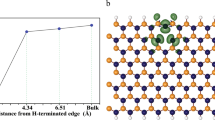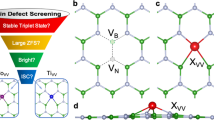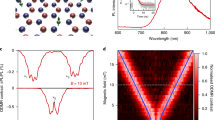Abstract
A plethora of single-photon emitters have been identified in the atomic layers of two-dimensional van der Waals materials1,2,3,4,5,6,7,8. Here, we report on a set of isolated optical emitters embedded in hexagonal boron nitride that exhibit optically detected magnetic resonance. The defect spins show an isotropic ge-factor of ~2 and zero-field splitting below 10 MHz. The photokinetics of one type of defect is compatible with ground-state electron-spin paramagnetism. The narrow and inhomogeneously broadened magnetic resonance spectrum differs significantly from the known spectra of in-plane defects. We determined a hyperfine coupling of ~10 MHz. Its angular dependence indicates an unpaired, out-of-plane delocalized π-orbital electron, probably originating from substitutional impurity atoms. We extracted spin–lattice relaxation times T1 of 13–17 μs with estimated spin coherence times T2 of less than 1 μs. Our results provide further insight into the structure, composition and dynamics of single optically active spin defects in hexagonal boron nitride.
This is a preview of subscription content, access via your institution
Access options
Access Nature and 54 other Nature Portfolio journals
Get Nature+, our best-value online-access subscription
$29.99 / 30 days
cancel any time
Subscribe to this journal
Receive 12 print issues and online access
$259.00 per year
only $21.58 per issue
Buy this article
- Purchase on Springer Link
- Instant access to full article PDF
Prices may be subject to local taxes which are calculated during checkout




Similar content being viewed by others
Data availability
Source data are provided with this paper. Any further data are available from the corresponding author upon request.
Code availability
All fits to the data were made with the commercial plotting software Origin. The fit functions and Matlab code (Easy spin) used for simulating the hyperfine coupling parameters can be made available upon request. The first-principles calculations were carried out using a standard but non-free ab initio plane-wave supercell software package.
References
Srivastava, A. et al. Optically active quantum dots in monolayer WSe2. Nat. Nanotechnol. 10, 491–496 (2015).
Cassabois, G., Valvin, P. & Gil, B. Hexagonal boron nitride is an indirect bandgap semiconductor. Nat. Photonics 10, 262–266 (2016).
Tran, T. T., Bray, K., Ford, M. J., Toth, M. & Aharonovich, I. Quantum emission from hexagonal boron nitride monolayers. Nat. Nanotechnol. 11, 37–41 (2015).
Chejanovsky, N. et al. Structural attributes and photodynamics of visible spectrum quantum emitters in hexagonal boron nitride. Nano Lett. 16, 7037–7045 (2016).
Shotan, Z. et al. Photoinduced modification of single-photon emitters in hexagonal boron nitride. ACS Photonics 3, 2490–2496 (2016).
Vogl, T. et al. Radiation tolerance of two-dimensional material-based devices for space applications. Nat. Commun. 10, 1202 (2019).
Martinez, L. J. et al. Efficient single photon emission from a high-purity hexagonal boron nitride crystal. Phys. Rev. B 94, 121405(R) (2016).
Chejanovsky, N. et al. Quantum light in curved low dimensional hexagonal boron nitride systems. Sci. Rep. 7, 14758 (2017).
Abdi, M., Chou, J.-P., Gali, A. & Plenio, M. B. Color centers in hexagonal boron nitride monolayers: a group theory and ab initio analysis. ACS Photonics 5, 1967–1976 (2018).
Sajid, A., Reimers, J. R. & Ford, M. J. Defect states in hexagonal boron nitride: assignments of observed properties and prediction of properties relevant to quantum computation. Phys. Rev. B 97, 064101 (2018).
Exarhos, A. L., Hopper, D. A., Patel, R. N., Doherty, M. W. & Bassett, L. C. Magnetic-field-dependent quantum emission in hexagonal boron nitride at room temperature. Nat. Commun. 10, 222 (2019).
Gottscholl, A. et al. Initialization and readout of intrinsic spin defects in a van der Waals crystal at room temperature. Nat. Mater. 19, 540–545 (2020).
Taniguchi, T. & Watanabe, K. Synthesis of high-purity boron nitride single crystals under high pressure by using Ba–BN solvent. J. Cryst. Growth 303, 525–529 (2007).
Exarhos, A. L., Hopper, D. A., Grote, R. R., Alkauskas, A. & Bassett, L. C. Optical signatures of quantum emitters in suspended hexagonal boron nitride. ACS Nano 11, 3328–3336 (2017).
Bommer, A. & Becher, C. New insights into nonclassical light emission from defects in multi-layer hexagonal boron nitride. Nanophotonics 8, 2041–2048 (2019).
Mendelson, N. et al. Identifying carbon as the source of visible single photon emission from hexagonal boron nitride. Nat. Mater. 20, 321–328 (2021).
Moore, A. W. & Singer, L. S. Electron spin resonance in carbon-doped boron nitride. J. Phys. Chem. Solids 33, 343–356 (1972).
Fanciulli, M. Electron paramagnetic resonance and relaxation in BN and BN: C. Philos. Mag. B 76, 363–381 (1997).
Khatri, P. et al. Optical gating of photoluminescence from color centers in hexagonal boron nitride. Nano Lett. 20, 4256–4263 (2020).
Boll, M. K. et al. Photophysics of quantum emitters in hexagonal boron-nitride nano-flakes. Opt. Express 28, 7475–7487 (2020).
Kianinia, M. et al. All-optical control and super-resolution imaging of quantum emitters in layered materials. Nat. Commun. 9, 874 (2018).
Geist, D. & Römelt, G. Paramagnetische elektronenresonanz in bornitrid. Solid State Commun. 2, 149 (1964).
Katzir, A., Suss, J. T., Zunger, A. & Halperin, A. Point defects in hexagonal boron nitride. I. EPR, thermoluminescence, and thermally-stimulated-current measurements. Phys. Rev. B 11, 2370 (1975).
Gezalov, K. B., Gasanov, A. M., Garibov, A. A., Aliev, M. & Musaev, N. The nature of paramagnetic centers in γ-irradiated boron oxide. Phys. Status Solidi A 117, K57–K60 (1990).
Cataldo, F. & Iglesias-Groth, S. Neutron damage of hexagonal boron nitride: h-BN. J. Radioanal. Nucl. Chem. 313, 261–271 (2017).
Krasnoperov, V. A., Veksjhina, N. N., Khusidman, M. B. & Neshpor, V. S. Luminescence and paramagnetic resonance of boron nitride. Zh. Prikl. Spektrosk. 11, 931–934 (1969).
Carrington, A. & McLachlan, A. D. Introduction to Magnetic Resonance: With Applications to Chemistry and Chemical Physics (Harper International & John Weatherhill, 1967).
Ye, M., Seo, H. & Galli, G. Spin coherence in two-dimensional materials. NPJ Comput. Mater. 5, 44 (2019).
Fanciulli, M. & Moustakas, T. D. Study of defects in wide band gap seminconductors by electron paramagnetic resonance. Phys. B 185, 228–233 (1993).
Acknowledgements
We acknowledge support from the Max Planck Society, the EU through project ASTERIQS and the ERC grant SMeL (Grant No. 742610) as well as the DFG. J.H.S. acknowledges financial support from the EU Graphene Flagship Core 3 Project. A.G. acknowledges support from the National Office of Research, Development and Innovation of Hungary (NKFIH) within the National Excellence Program (Grant No. KKP129866) as well as the National Quantum Technology Program (Grant No. 2017-1.2.1-NKP-2017-00001), and from the Ministry of Innovation and Technology of Hungary within the National Quantum Informatics Laboratory. The growth of h-BN crystals was sponsored by the Elemental Strategy Initiative conducted by MEXT, Japan (Grant No. JPMXP0112101001), JSPS KAKENHI (Grant No. JP20H00354) and the CREST (Grant No. JPMJCR15F3), JST. The work at DGIST was supported by the Basic Science Research Program (NRF-2020R1C1C1006914) through the National Research Foundation of Korea (NRF), and also by the DGIST R&D Program (20-CoE-NT-01), funded by the Korea Ministry of Science and ICT. We thank M. W. Doherty for fruitful discussions.
Author information
Authors and Affiliations
Contributions
All authors contributed to the paper. N.C., A.M., J.G. and Y.-C.C. contributed equally. N.C., J.W. and A.F. conceived and designed the experiments. T.T. and K.W. grew the single-crystal h-BN material. Y.K. and N.C. prepared the h-BN samples. A.D. fabricated the NV−-implanted diamond. N.C., A.M., J.G. and Y.-C.C. performed all measurements. P.A. and A.G. carried out the first-principles calculations and analysed the results. N.C., A.M., D.B.R.D. and J.W. analysed the data. J.W. and J.H.S. supervised the project. N.C. and A.M. wrote the manuscript with input from J.W., D.B.R.D., A.F., A.G. and J.H.S.
Corresponding authors
Ethics declarations
Competing interests
The authors declare no competing interests.
Additional information
Peer review information Nature Materials thanks the anonymous reviewers for their contribution to the peer review of this work.
Publisher’s note Springer Nature remains neutral with regard to jurisdictional claims in published maps and institutional affiliations.
Extended data
Extended Data Fig. 1 Confocal scans and identification.
a, The top panel displays spatial dependence of the emission for laser excitation at 633 nm wavelength. The bottom panel shows a confocal scan using low power excitation at 532 nm wavelength. It reveals that the emitter is located within the h-BN flake. The white scale bar corresponds to one micron. b, High resolution confocal scan of the emitter for 633 nm excitation. The emitter is less localized in comparison to the spread of another non-paramagnetic single emitter, (black bars represents the spatial extension in x and y profiles). For 35 µW power of 633 nm laser excitation. The white scale bar corresponds to 400 nm.
Extended Data Fig. 2 Optical polarization and auto-correlation.
(Top) The background uncorrected data for g2(t) is shown for defects D1 and D2. (Bottom) The photoluminescence intensity of defect D1 (left) and defect D2 (right) as a function of the linear polarization orientation of the incident laser light. The data points (grey dots) were recorded at 8.5 K. The solid lines are fits to the data sets as described in the text.
Extended Data Fig. 3 Phonon map for emitters D1, D2, D3.
Normalized PL intensity as a function of the energy detuning away from the zero phonon line (ZPL). This graph illustrates the importance of phonon coupling for emitter D1 (blue), D2 (red) and D3 (green) for 633 nm laser light excitation.
Extended Data Fig. 4 Non-paramagnetic emitter g2(t) and room temperature PL.
a, Auto-correlation function g2 (t) of a non-paramagnetic emitter with a similar emission wave length as the paramagnetic emitters discussed in the main text. b, The emission spectrum of this non-paramagnetic emitter.
Extended Data Fig. 5 Field characterization using NV centers in diamond.
a, NV ODMR measurements b, Illustration of the angle between the magnetic field and the optical axis of the h-BN QE c, A schematic of the translation of the magnetic field angle relative to the NV− center d, Magnetic field angle calibration from NV to h-BN emitter. e, The h-BN QE ODMR peak frequency as a function of the angle. The grey values refer to the magnetic field strength.
Extended Data Fig. 6 Kinetics of the electronic states.
a, Energy level diagram used for modeling. b, Fluorescence autocorrelation measurement for longer time scales. The solid curve is a four parameter fit. The extracted time scale is indicated on the curve c, Fluorescence intensity dependence on the excitation laser power. The arrow indicates the laser power for which most measurements were carried out. Otherwise the power level is stated. The solid curve is a parabolic fit, the dashed line represents the linear component of the fit. d, Record of the PL intensity as a function of the delay time the two excitation sequences shown in the inset. In comparison with the behavior of the PL intensity during sequence 1, the fluorescence saturates at a lower value for simultaneous excitation of laser and MW radiation (sequence 2). This suggests shelving into a long lived metastable state during the initial laser excitation pulse in sequence 1. e, Fluorescence recovery curves for the different pulse sequences shown in the inset. f, Same as (e) but for longer delay times. The data indicate a lifetime of the long lived (ll) metastable state greater than 20 ms. g, The re-pump process is probed with the sequences shown in the inset. During sequence 2 the population is pumped into the ll state by the initial combined MW and laser pulse and subsequently repumped into state e2 during the probe laser pulse of variable width before the final fixed readout pulse. In contrast, during sequence 1 the population is not pumped into the ll state. The recovery of the ground state population due to the laser re-pump mechanism in the absence of MW is evident. The solid line is a simulation based on the energy level diagram model.
Extended Data Fig. 7 Hyperfine decomposition of the ODMR for different microwave power levels and T2* calculation.
a, Power dependent measurements for defect D1 at a fixed magnetic field of 155G. b, Lorentzian fits to the second (red) and third peak of the decomposed ODMR line shape. c, Lifetime T2* extracted from the data in panel (a) assuming coupling to a one boron center. The outermost signal components are not considered for the estimation of T2* as they are too weak. Hence, the lifetime is calculated using only the second (red) and third (orange) peak 2 (red) and 3 (orange) in panel (a). d, Estimates of T2* for defect D2.
Extended Data Fig. 8 Calculated Hyperfine couplings and ODMR.
Calculation of the ODMR lineshape for defect D1 based on the hyperfine coupling calculated from the point defects: a, CB, b, CB(+)CN(0)-DAP-2, c, CB(0)CN(-)-DAP-4, d, C2CN trimer (see table 2.1, 2.2, 2.3 and 2.4). Since NMR active carbon is rare (13C, 1.1%), only boron (11B, 80.1%) and nitrogen (14N, 99.6%) are assumed to contribution to the line broadening. The calculations are given as stick spectrum, that is only spectral components are shown but not natural linewidth is assumed.
Extended Data Fig. 9 Photoluminescence (PL) of defect candidates-DFT.
Photoluminescence (PL) of defect candidates that could indicate the experimentally isolated optical emitter D1: a, Comparison of PL spectra, b, comparison of phonon sidebands (PSBs).
Extended Data Fig. 10 Estimate of lifetime T1.
a, Pulsed ODMR sequence. A 500ns MW pulse is applied after simultaneous laser and MW excitation (sequence 1) or only laser pulse excitation (sequence 2). The time delay between initial excitation and the readout pulse is varied. Each sequence is repeated 20.000 times (N = 20k) for every measurement frequency in order to enhance the signal-to-noise ratio of the ODMR. b, Simulation for the ODMR contrast as a function of the delay time when assuming T1 approaches ∞. The ODMR contrast increases with deay time. c, Experimental ODMR data for both measurement sequences. Simulation assuming T1= ∞ is shown in the right top indicate increasing contrast with time delay. The extracted time decay constant is plotted next to each curve. d, Simulation of the ODMR contrast as a function of time delay assuming T1=10 µs. The time decay constant is comparable to what is observed in the data.
Supplementary information
Supplementary Information
Supplementary Figs. 1–13, Tables 1 and 2.1–2.4 and discussion.
Source data
Source Data Fig. 1
Raw data—data points of figure.
Source Data Fig. 2
Raw data—data points of figure.
Source Data Fig. 3
Raw data—data points of figure.
Source Data Fig. 4
Raw data—data points of figure.
Source Data Extended Data Fig. 1
Raw data—data points of figure.
Source Data Extended Data Fig. 2
Raw data—data points of figure.
Source Data Extended Data Fig. 3
Raw data—data points of figure.
Source Data Extended Data Fig. 4
Raw data—data points of figure.
Source Data Extended Data Fig. 5
Raw data—data points of figure.
Source Data Extended Data Fig. 6
Raw data—data points of figure.
Source Data Extended Data Fig. 7
Raw data—data points of figure.
Source Data Extended Data Fig. 8
Raw data—data points of figure.
Source Data Extended Data Fig. 9
Raw data—data points of figure.
Source Data Extended Data Fig. 10
Raw data—data points of figure.
Rights and permissions
About this article
Cite this article
Chejanovsky, N., Mukherjee, A., Geng, J. et al. Single-spin resonance in a van der Waals embedded paramagnetic defect. Nat. Mater. 20, 1079–1084 (2021). https://doi.org/10.1038/s41563-021-00979-4
Received:
Accepted:
Published:
Issue Date:
DOI: https://doi.org/10.1038/s41563-021-00979-4
This article is cited by
-
Exceptionally strong coupling of defect emission in hexagonal boron nitride to stacking sequences
npj 2D Materials and Applications (2024)
-
Room temperature optically detected magnetic resonance of single spins in GaN
Nature Materials (2024)
-
Arbitrarily structured quantum emission with a multifunctional metalens
eLight (2023)
-
Dopant-assisted stabilization of negatively charged single nitrogen-vacancy centers in phosphorus-doped diamond at low temperatures
npj Quantum Information (2023)
-
Layered materials as a platform for quantum technologies
Nature Nanotechnology (2023)



